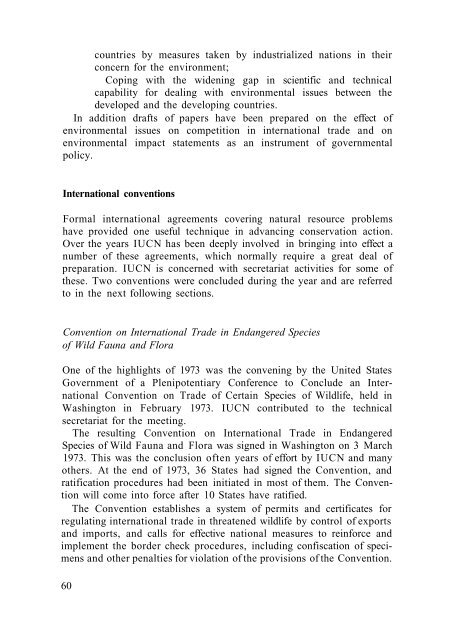1973 iucn yearbook
1973 iucn yearbook
1973 iucn yearbook
You also want an ePaper? Increase the reach of your titles
YUMPU automatically turns print PDFs into web optimized ePapers that Google loves.
countries by measures taken by industrialized nations in their<br />
concern for the environment;<br />
Coping with the widening gap in scientific and technical<br />
capability for dealing with environmental issues between the<br />
developed and the developing countries.<br />
In addition drafts of papers have been prepared on the effect of<br />
environmental issues on competition in international trade and on<br />
environmental impact statements as an instrument of governmental<br />
policy.<br />
International conventions<br />
Formal international agreements covering natural resource problems<br />
have provided one useful technique in advancing conservation action.<br />
Over the years IUCN has been deeply involved in bringing into effect a<br />
number of these agreements, which normally require a great deal of<br />
preparation. IUCN is concerned with secretariat activities for some of<br />
these. Two conventions were concluded during the year and are referred<br />
to in the next following sections.<br />
Convention on International Trade in Endangered Species<br />
of Wild Fauna and Flora<br />
One of the highlights of <strong>1973</strong> was the convening by the United States<br />
Government of a Plenipotentiary Conference to Conclude an International<br />
Convention on Trade of Certain Species of Wildlife, held in<br />
Washington in February <strong>1973</strong>. IUCN contributed to the technical<br />
secretariat for the meeting.<br />
The resulting Convention on International Trade in Endangered<br />
Species of Wild Fauna and Flora was signed in Washington on 3 March<br />
<strong>1973</strong>. This was the conclusion often years of effort by IUCN and many<br />
others. At the end of <strong>1973</strong>, 36 States had signed the Convention, and<br />
ratification procedures had been initiated in most of them. The Convention<br />
will come into force after 10 States have ratified.<br />
The Convention establishes a system of permits and certificates for<br />
regulating international trade in threatened wildlife by control of exports<br />
and imports, and calls for effective national measures to reinforce and<br />
implement the border check procedures, including confiscation of specimens<br />
and other penalties for violation of the provisions of the Convention.<br />
60

















